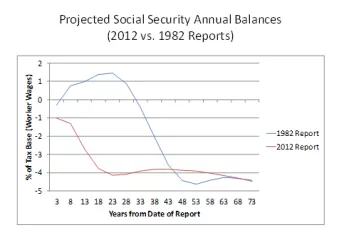- | Academic & Student Programs Academic & Student Programs
- | Expert Commentary Expert Commentary
- |
'Pay-As-You-Go' Threatens the Future of Retirement
Congressional Democrats’ recent reintroduction of the Social Security 2100 Act, which would expand Social Security benefits for many Americans, could do us all a great service — not by becoming law, but by putting our entitlement funding crisis into sharper focus.
With spending on Social Security approaching $980 billion in 2018, and with projections rising to $1.8 trillion in the next decade, ensuring the program’s financial sustainability for future generations has never been more critical. Leaders cannot keep ignoring Social Security’s inherent funding issues with more continuing resolutions that fund the government for short periods of time, endlessly kicking the can down the road and saving the real debate for another day. This is what keeps government under threat of fiscal insolvency.
The original Social Security Act of 1935 established three different types of programs to provide economic security for three specific groups of Americans: old-age insurance for retirees in the form of Social Security, unemployment insurance, and aid to families with children, a precursor of the Temporary Aid to Needy Families (TANF) program.
Most debate surrounds the assistance provided to retirees, who under the act’s original design were guaranteed to be refunded the amount they had paid in, at minimum. Under this design, Social Security operated as a fully funded program: Workers who paid in were told that their payments would be enough, with interest, to fund the program’s benefits.
However, just four years after the Social Security Act was enacted, amendments began to change the original benefit formula, prioritizing families and workers who were close to retiring, a politically popular move at the time.
Now, rather than being determined by a worker’s total contributions over a lifetime, Social Security payouts are determined by a formula based on that worker’s past taxable income. This helped transform Social Security into the “pay-as-you-go” program it is today, where today’s workers pay for yesterday’s, without any guarantees regarding future funding.
These days, Social Security hardly looks like a good deal for most Americans. A Congressional Research Services Report predicted that average retirees in 2003 would wait more than 17 years to earn back Social Security contributions plus interest. For those retiring in 2020, this payback period grows to nearly 22 years.
Returns on the investments made with our Social Security dollars are even poorer. A Tax Foundation study found that in nearly all cases, placing similar amounts of money in personal, tax-preferred savings accounts dramatically outperforms Social Security yields.
Social Security is rapidly approaching a time in which it can no longer self-fund its liabilities. As costs rise and America’s population growth declines, insolvency becomes an increasingly credible threat. The most recent program trustees’ reports determine that Social Security will become insolvent in 2034.
If policymakers continue to kick the can, the costs of correcting things will fall onto future generations through benefit cuts or higher taxes — and we cannot ask younger Americans to finance both the retirements of previous generations and their own at once.
In the meantime, the most viable (and politically toughest) solution to the “pay-as-you-go” problem is reducing current and future benefits in a fair and manageable way. Raising the full retirement age and cutting benefits for high earners are just two ways Rep. Sam Johnson, R-Texas, proposed doing this in 2016. His bill — the last notable, formal proposal along these lines — could be looked at as a starting point.
Social Security simply isn’t built to serve as the all-purpose retirement income program politicians want it to become. Just as it was in 1939, the political pressure to prioritize current beneficiaries — who happen to be a powerful voting bloc — is strong. But what was designed as an insurance program is not a replacement for private retirement income planning and savings.
It is time to save ourselves from “pay-as-you-go.”
